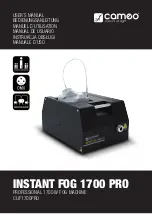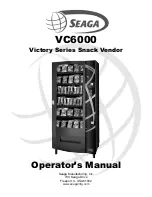
8 ENGLISH
Kickback is the result of power tool misuse and/or
incorrect operating procedures or conditions and can be
avoided by taking proper precautions as given below.
1.
Maintain a firm grip on the power tool and posi
-
tion your body and arm to allow you to resist
kickback forces.
The operator can control upward
kickback forces, if proper precautions are taken.
2.
Do not position your body in line with the
rotating wheel.
If kickback occurs, it will propel
the cutting unit upwards toward the operator.
3.
Do not attach a saw chain, woodcarving blade,
segmented diamond wheel with a peripheral
gap greater than 10 mm or toothed saw blade.
Such blades create frequent kickback and loss of
control.
4.
Do not “jam” the wheel or apply excessive
pressure. Do not attempt to make an excessive
depth of cut.
Overstressing the wheel increases
the loading and susceptibility to twisting or binding
of the wheel in the cut and the possibility of kick
-
back or wheel breakage.
5.
When the wheel is binding or when interrupt
-
ing a cut for any reason, switch off the power
tool and hold the cutting unit motionless until
the wheel comes to a complete stop. Never
attempt to remove the wheel from the cut while
the wheel is in motion otherwise kickback may
occur.
Investigate and take corrective action to
eliminate the cause of wheel binding.
6.
Do not restart the cutting operation in the
workpiece. Let the wheel reach full speed and
carefully re-enter the cut.
The wheel may bind,
walk up or kickback if the power tool is restarted in
the workpiece.
7.
Support any oversized workpiece to minimize
the risk of wheel pinching and kickback.
Large
workpieces tend to sag under their own weight.
Supports must be placed under the workpiece
near the line of cut and near the edge of the work-
piece on both sides of the wheel.
Additional safety warnings
1.
Watch out for flying sparks when operating.
They can cause injury or ignite combustible
materials.
2.
Secure work. Use clamps or a vise to hold
work when practical.
It's safer than using your
hand and it frees both hands to operate tool.
3.
Secure the cut-off wheel carefully.
4.
Be careful not to damage the spindle, flanges
(especially the installing surface) or bolt, or
the cut-off wheel itself might break.
5.
Keep guards in place and in working order.
6.
Hold the handle firmly.
7.
Keep hands away from rotating parts.
8.
Make sure the cut-off wheel is not contacting
the work-piece before the switch is turned on.
9.
Before each use, watch for flutter or excessive
vibration that might be caused by poor instal
-
lation or a poorly balanced wheel.
10.
Remove material or debris from the area
that might be ignited by sparks. Be sure that
others are not in the path of the sparks. Keep
a proper, charged fire extinguisher closely
available.
11.
If the cut-off wheel stops during the opera
-
tion, makes an odd noise or begins to vibrate,
switch off the tool immediately.
12.
Always switch off and wait for the cut-off
wheel to come to a complete stop before
removing, securing workpiece, working vise,
changing work position, angle or the cut-off
wheel itself.
13.
Do not touch the workpiece immediately after
operation; it is extremely hot and could burn
your skin.
14.
Store wheels in a dry location only.
SAVE THESE INSTRUCTIONS.
Important safety instructions for
battery cartridge
1.
Before using battery cartridge, read all instruc
-
tions and cautionary markings on (1) battery
charger, (2) battery, and (3) product using
battery.
2.
Do not disassemble battery cartridge.
3.
If operating time has become excessively
shorter, stop operating immediately. It may
result in a risk of overheating, possible burns
and even an explosion.
4.
If electrolyte gets into your eyes, rinse them
out with clear water and seek medical atten
-
tion right away. It may result in loss of your
eyesight.
5.
Do not short the battery cartridge:
(1)
Do not touch the terminals with any con
-
ductive material.
(2)
Avoid storing battery cartridge in a con
-
tainer with other metal objects such as
nails, coins, etc.
(3)
Do not expose battery cartridge to water
or rain.
A battery short can cause a large current
flow, overheating, possible burns and even a
breakdown.
6.
Do not store the tool and battery cartridge in
locations where the temperature may reach or
exceed 50 °C (122 °F).
7.
Do not incinerate the battery cartridge even if
it is severely damaged or is completely worn
out. The battery cartridge can explode in a fire.
8.
Be careful not to drop or strike battery.
9.
Do not use a damaged battery.
10.
The contained lithium-ion batteries are subject
to the Dangerous Goods Legislation require
-
ments.
For commercial transports e.g. by third parties,
forwarding agents, special requirement on pack
-
aging and labeling must be observed.
For preparation of the item being shipped, consult
-
ing an expert for hazardous material is required.
Please also observe possibly more detailed
national regulations.
Tape or mask off open contacts and pack up the
battery in such a manner that it cannot move
around in the packaging.
Summary of Contents for DLW140
Page 2: ...1 2 Fig 1 1 Fig 2 2 1 3 Fig 3 1 1 2 Fig 4 1 2 Fig 5 1 2 Fig 6 1 Fig 7 1 2 Fig 8 2 ...
Page 3: ...1 2 Fig 9 1 2 Fig 10 1 Fig 11 1 Fig 12 Fig 13 Fig 14 1 2 Fig 15 3 ...
Page 4: ...1 3 4 2 6 5 Fig 16 1 2 3 Fig 17 1 Fig 18 1 2 3 4 Fig 19 Fig 20 1 2 3 4 Fig 21 1 Fig 22 4 ...
Page 5: ...Fig 23 5 ...
Page 90: ...90 ...
Page 91: ...91 ...









































